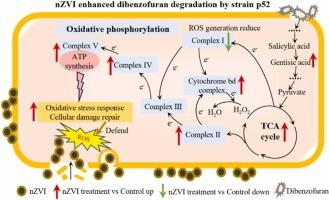纳米零价铁在促进罗氏球菌降解二苯并呋喃中的作用机制ATP 生产与保护活性氧之间的权衡
IF 12.2
1区 环境科学与生态学
Q1 ENGINEERING, ENVIRONMENTAL
引用次数: 0
摘要
纳米零价铁(nZVI)可以促进污染物的生物降解,但它对微生物有毒性。与革兰氏阴性细菌相比,革兰氏阳性(G+)细菌对 nZVI 表现出更强的抵抗力。然而,nZVI 加速 G+ 细菌降解污染物的机制仍不清楚。在此,我们探讨了 nZVI 对 G+ 细菌 Rhodococcus sp. 菌株 p52 的影响,以及 nZVI 加速二苯并呋喃(一种典型的多环芳烃化合物)生物降解的机制。电子显微镜和能量色散光谱分析显示,氮化六六六能穿透细胞膜,造成细胞损伤和生长抑制。在一定浓度下,氮化六六六能促进二苯并呋喃的生物降解,而高浓度则由于延迟缓解活性氧(ROS)而较晚发挥作用。转录组分析表明,细胞采用了响应机制来处理 nZVI 诱导的高浓度 ROS。二苯并呋喃降解的加速提高了 ATP 的产生,为与抗氧化压力和损伤修复相关的蛋白质合成提供了能量。同时,电子传递链(ETC)也进行了调整,以缓解 ROS 的积累,其中包括下调 ETC 复合物 I 相关基因的表达,以及上调清除 ROS 的细胞色素 bd 复合物和 ETC 复合物 II 基因的表达。这些发现揭示了氮化六六六增强 G+ 细菌生物降解的机制,为优化涉及氮化六六六的生物修复战略提供了启示。本文章由计算机程序翻译,如有差异,请以英文原文为准。

Mechanisms of nano zero-valent iron in enhancing dibenzofuran degradation by a Rhodococcus sp.: Trade-offs between ATP production and protection against reactive oxygen species
Nano zero-valent iron (nZVI) can enhance pollutants biodegradation, but it displays toxicity towards microorganisms. Gram-positive (G+) bacteria exhibit greater resistance to nZVI than Gram-negative bacteria. However, mechanisms of nZVI accelerating pollutants degradation by G+ bacteria remain unclear. Herein, we explored effects of nZVI on a G+ bacterium, Rhodococcus sp. strain p52, and mechanisms by which nZVI accelerates biodegradation of dibenzofuran, a typical polycyclic aromatic compound. Electron microscopy and energy dispersive spectroscopy analysis revealed that nZVI could penetrate cell membranes, which caused damage and growth inhibition. nZVI promoted dibenzofuran biodegradation at certain concentrations, while higher concentration functioned later due to the delayed reactive oxygen species (ROS) mitigation. Transcriptomic analysis revealed that cells adopted response mechanisms to handle the elevated ROS induced by nZVI. ATP production was enhanced by accelerated dibenzofuran degradation, providing energy for protein synthesis related to antioxidant stress and damage repair. Meanwhile, electron transport chain (ETC) was adjusted to mitigate ROS accumulation, which involved downregulating expression of ETC complex I-related genes, as well as upregulating expression of the genes for the ROS-scavenging cytochrome bd complex and ETC complex II. These findings revealed the mechanisms underlying nZVI-enhanced biodegradation by G+ bacteria, offering insights into optimizing bioremediation strategies involving nZVI.
求助全文
通过发布文献求助,成功后即可免费获取论文全文。
去求助
来源期刊

Journal of Hazardous Materials
工程技术-工程:环境
CiteScore
25.40
自引率
5.90%
发文量
3059
审稿时长
58 days
期刊介绍:
The Journal of Hazardous Materials serves as a global platform for promoting cutting-edge research in the field of Environmental Science and Engineering. Our publication features a wide range of articles, including full-length research papers, review articles, and perspectives, with the aim of enhancing our understanding of the dangers and risks associated with various materials concerning public health and the environment. It is important to note that the term "environmental contaminants" refers specifically to substances that pose hazardous effects through contamination, while excluding those that do not have such impacts on the environment or human health. Moreover, we emphasize the distinction between wastes and hazardous materials in order to provide further clarity on the scope of the journal. We have a keen interest in exploring specific compounds and microbial agents that have adverse effects on the environment.
 求助内容:
求助内容: 应助结果提醒方式:
应助结果提醒方式:


